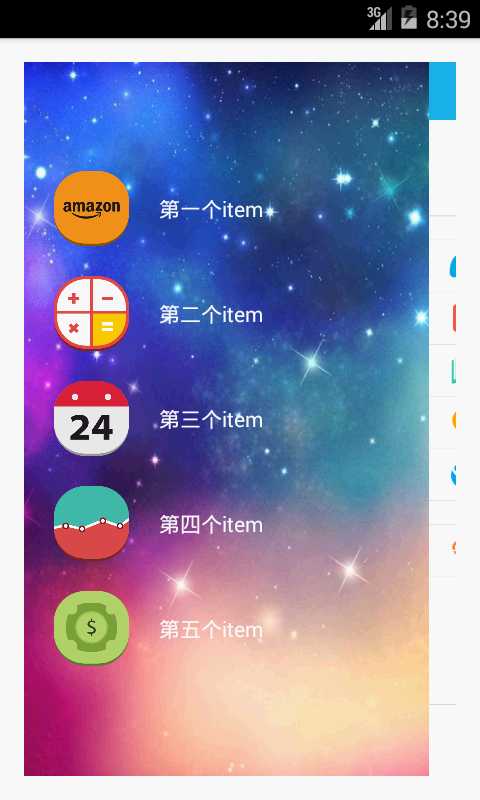标签:
对于新版的QQ界面,左侧增加了一个滑动效果,相信小伙伴们早已按耐不住激动的心情,这种效果是如何实现的呢?本篇我们就一起来探讨一二。既然是滑动效果这里就要使用到HorizontalScrollView类,一个水平滑动的效果。
对于这个效果我们可以分为一个Item Menu和Layout,通过对Item Menu设置padding值来隐藏和显示左侧的Menu菜单。
我们的Menu设计代码:
<?xml version="1.0" encoding="utf-8"?> <RelativeLayout xmlns:android="http://schemas.android.com/apk/res/android" android:layout_width="match_parent" android:layout_height="match_parent" android:background="@drawable/img_frame_background" > <LinearLayout android:layout_width="match_parent" android:layout_height="wrap_content" android:layout_centerInParent="true" android:orientation="vertical"> <RelativeLayout android:layout_width="match_parent" android:layout_height="match_parent"> <ImageView android:id="@+id/img1" android:layout_width="50dp" android:layout_height="50dp" android:src="@drawable/img_1" android:layout_marginLeft="20dp" android:layout_marginTop="20dp" android:layout_centerVertical="true" /> <TextView android:layout_width="wrap_content" android:layout_height="wrap_content" android:layout_marginLeft="20dp" android:textColor="#fff" android:text="第一个item" android:layout_toRightOf="@id/img1" android:layout_centerVertical="true" /> </RelativeLayout> <RelativeLayout android:layout_width="match_parent" android:layout_height="match_parent"> <ImageView android:id="@+id/img2" android:layout_width="50dp" android:layout_height="50dp" android:src="@drawable/img_2" android:layout_marginLeft="20dp" android:layout_marginTop="20dp" android:layout_centerVertical="true" /> <TextView android:layout_width="wrap_content" android:layout_height="wrap_content" android:layout_marginLeft="20dp" android:textColor="#fff" android:text="第二个item" android:layout_toRightOf="@id/img2" android:layout_centerVertical="true" /> </RelativeLayout> </LinearLayout> </RelativeLayout>
我们的主Activity的Layout代码:
<RelativeLayout xmlns:android="http://schemas.android.com/apk/res/android" xmlns:tools="http://schemas.android.com/tools" android:layout_width="match_parent" android:layout_height="match_parent" android:paddingBottom="@dimen/activity_vertical_margin" android:paddingLeft="@dimen/activity_horizontal_margin" android:paddingRight="@dimen/activity_horizontal_margin" android:paddingTop="@dimen/activity_vertical_margin" tools:context=".MainActivity" > <com.example.menu.SlidingMenu android:layout_width="match_parent" android:layout_height="match_parent"> <LinearLayout android:layout_width="wrap_content" android:layout_height="match_parent" android:orientation="horizontal" > <include layout="@layout/left_menu"/> <LinearLayout android:layout_width="match_parent" android:layout_height="match_parent" android:background="@drawable/qq" /> </LinearLayout> </com.example.menu.SlidingMenu> </RelativeLayout>
我们自定义的SlidingMenu:
package com.example.menu; import android.content.Context; import android.util.AttributeSet; import android.util.DisplayMetrics; import android.util.TypedValue; import android.view.MotionEvent; import android.view.ViewGroup; import android.view.WindowManager; import android.widget.HorizontalScrollView; import android.widget.LinearLayout; public class SlidingMenu extends HorizontalScrollView { private LinearLayout mWapper; private ViewGroup mMenu; private ViewGroup mContent; private int mScreenWidth;//屏幕的宽度 private int mMenuWidth;//设置Menu的宽度 //dp private int mMenuRightPadding; private boolean once = false; /** * 未使用自定义属性时调用此方法 * @param context * @param attrs */ public SlidingMenu(Context context, AttributeSet attrs) { super(context, attrs); WindowManager wm = (WindowManager) context.getSystemService(context.WINDOW_SERVICE); DisplayMetrics outMetrics = new DisplayMetrics(); wm.getDefaultDisplay().getMetrics(outMetrics ); mScreenWidth = outMetrics.widthPixels; //将dp转换为px mMenuRightPadding = (int) TypedValue.applyDimension(TypedValue.COMPLEX_UNIT_DIP, 50, context.getResources().getDisplayMetrics()); } /** * 设置内部View的宽和高,以及自己的宽和高 */ @Override protected void onMeasure(int widthMeasureSpec, int heightMeasureSpec) { super.onMeasure(widthMeasureSpec, heightMeasureSpec); if(!once){ mWapper = (LinearLayout) getChildAt(0); mMenu = (ViewGroup) mWapper.getChildAt(0); mContent = (ViewGroup) mWapper.getChildAt(1); mMenuWidth = mMenu.getLayoutParams().width = mScreenWidth - mMenuRightPadding; mContent.getLayoutParams().width = mScreenWidth; once = true; } } /** * 设置子View的放置位置 * 通过设置偏移量来隐藏Menu */ @Override protected void onLayout(boolean changed, int l, int t, int r, int b) { super.onLayout(changed, l, t, r, b); if(changed){ this.scrollTo(mMenuWidth, 0); } } /** * 控制手指的滑动效果 */ @Override public boolean onTouchEvent(MotionEvent ev) { int action = ev.getAction(); switch (action) { case MotionEvent.ACTION_UP: int scrollx = getScrollX();//Menu左侧隐藏的区域宽度 if(scrollx >= mMenuWidth/2){ this.smoothScrollTo(mMenuWidth, 0); }else{ this.smoothScrollTo(0, 0); } return true; } return super.onTouchEvent(ev); } }
我们的主Activity:
public class MainActivity extends Activity { @Override protected void onCreate(Bundle savedInstanceState) { super.onCreate(savedInstanceState); requestWindowFeature(Window.FEATURE_NO_TITLE);//去除标题 setContentView(R.layout.activity_main); } }
效果图:

标签:
原文地址:http://www.cnblogs.com/AndroidJotting/p/4469885.html